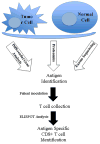Vaccines for pancreatic cancer
- PMID: 23187853
- PMCID: PMC3539747
- DOI: 10.1097/PPO.0b013e3182756903
Vaccines for pancreatic cancer
Abstract
Pancreatic ductal adenocarcinoma (PDA) remains a highly lethal disease; new therapeutic modalities are urgently needed. A number of immunotherapies tested in preclinical models have shown promise. Early-phase clinical trials have demonstrated evidence of immune activation that in some cases correlates with clinical response. Moreover, recent evidence delineates the intricate role of inflammation in PDA, even at its earliest stages. Pancreatic ductal adenocarcinoma is thus ripe for immunotherapy; however, significant challenges remain before success can be realized. Future studies will need to focus on the discovery of novel PDA antigens and the identification of the multiple immune suppressive pathways within the PDA tumor microenvironment that inhibit an effective PDA-targeted immune response. Technologies are now available to rapidly advance discovery. Rapid translation of new discoveries into scientifically driven clinical trials testing combinations of immune agents will likely continue to shift the procarcinogenic tumor environment toward the most potent anticancer response.
Conflict of interest statement
Figures




Similar articles
-
Rational combinations of immunotherapy for pancreatic ductal adenocarcinoma.Chin Clin Oncol. 2017 Jun;6(3):31. doi: 10.21037/cco.2017.06.04. Chin Clin Oncol. 2017. PMID: 28705008 Free PMC article.
-
Immunotherapy for pancreatic ductal adenocarcinoma.J Surg Oncol. 2021 Mar;123(3):751-759. doi: 10.1002/jso.26312. J Surg Oncol. 2021. PMID: 33595893 Review.
-
Mechanisms Governing Immunotherapy Resistance in Pancreatic Ductal Adenocarcinoma.Front Immunol. 2021 Jan 28;11:613815. doi: 10.3389/fimmu.2020.613815. eCollection 2020. Front Immunol. 2021. PMID: 33584701 Free PMC article. Review.
-
Wilms' tumor 1 (WT1)-targeted cancer vaccines to extend survival for patients with pancreatic cancer.Immunotherapy. 2016 Nov;8(11):1309-1320. doi: 10.2217/imt-2016-0031. Immunotherapy. 2016. PMID: 27993090 Review.
-
Novel pancreatic cancer vaccines could unleash the army within.Cancer Control. 2014 Jul;21(3):242-6. doi: 10.1177/107327481402100311. Cancer Control. 2014. PMID: 24955709 Review.
Cited by
-
The dark side of immunotherapy: pancreatic cancer.Cancer Drug Resist. 2020 May 11;3(3):491-520. doi: 10.20517/cdr.2020.13. eCollection 2020. Cancer Drug Resist. 2020. PMID: 35582441 Free PMC article. Review.
-
Immunotherapy for pancreatic cancer: Barriers and breakthroughs.Ann Gastroenterol Surg. 2018 Jun 22;2(4):274-281. doi: 10.1002/ags3.12176. eCollection 2018 Jul. Ann Gastroenterol Surg. 2018. PMID: 30003190 Free PMC article. Review.
-
A randomized pilot phase I study of modified carcinoembryonic antigen (CEA) peptide (CAP1-6D)/montanide/GM-CSF-vaccine in patients with pancreatic adenocarcinoma.J Immunother Cancer. 2013 Jun 27;1:8. doi: 10.1186/2051-1426-1-8. eCollection 2013. J Immunother Cancer. 2013. PMID: 24829746 Free PMC article.
-
Reprogramming the tumor microenvironment: tumor-induced immunosuppressive factors paralyze T cells.Oncoimmunology. 2015 Apr 1;4(7):e1016700. doi: 10.1080/2162402X.2015.1016700. eCollection 2015 Jul. Oncoimmunology. 2015. PMID: 26140242 Free PMC article. Review.
-
Immune monitoring and TCR sequencing of CD4 T cells in a long term responsive patient with metastasized pancreatic ductal carcinoma treated with individualized, neoepitope-derived multipeptide vaccines: a case report.J Transl Med. 2018 Feb 6;16(1):23. doi: 10.1186/s12967-018-1382-1. J Transl Med. 2018. PMID: 29409514 Free PMC article.
References
-
- American Cancer Society. Society AC. Cancer Facts & Figures 2012. 2012
-
- Hruban RH, Goggins M, Parsons J, et al. Progression model for pancreatic cancer. Clin Cancer Res. 2000;6(8):2969–2972. - PubMed
-
- Clark CE, Beatty GL, Vonderheide RH. Immunosurveillance of pancreatic adenocarcinoma: insights from genetically engineered mouse models of cancer. Cancer Lett. 2009;279(1):1–7. - PubMed
-
- Kubuschok B, Xie X, Jesnowski R, et al. Expression of cancer testis antigens in pancreatic carcinoma cell lines, pancreatic adenocarcinoma and chronic pancreatitis. Int J Cancer. 2004;109(4):568–575. - PubMed
Publication types
MeSH terms
Substances
Grants and funding
LinkOut - more resources
Full Text Sources
Other Literature Sources
Medical

